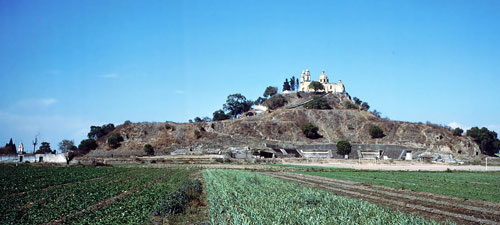Day 1
We just returned from an immersive journey into the heart of archaeological Mesoamerica! A seven-day adventure, it was a truly unique experience digging into the pre-Hispanic history of Mexico. I, my driver Daniel and five travelers left San Miguel the morning of Monday, May 4th and headed out towards our first destination, the magical Epi-classic hilltop sites of Cacaxtla-Xochitécatl which are located right near the Tlaxcala/Puebla border. They are located strategically on a volcanic dome that overlooks the Tlaxcala/Puebla valley and are within view of the majestic and mystical volcanoes Popocatépetl, Ixtaccíhuatl and La Malinche. We took the toll highways of the northern arc to avoid passing through Mexico City, which cut down on travel time immensely allowing us the chance to enjoy touring the sites at a leisurely pace before heading to our first night’s accommodations in nearby Cholula, Puebla.

A high point of the first day at Cacaxtla was when we beheld the strikingly well-preserved Mayan style painted murals that were discovered there by looters in 1974. Yes, Cacaxtla is one of the only Mayan ruins in central Mexico! Mayan gods, agricultural scenes, astronomical and calendrical themes, a vivid and graphic battle scene that shows jaguar and eagle warriors engaged in intense combat and colorful images of different versions of the feathered serpent were showcased around the ceremonial center. The Putún Maya, otherwise known as the Olmeca-Xicallanca, were sea traders who probably came from the shores of Campeche and made intrusions into central Mexico, seizing important trade routes and resources as they took advantage of the power vacuum left after the collapse of the great city of Teotihuacán at the end of the Classic period (600-900 A.D.). Hence the name Cacaxtla which comes from the Náhuatl word cacaxtli that refers to the wooden back racks worn by long distance traders and merchants.
Xochitécatl, or Place of Flowers, is located just 1 kilometer west of Cacaxtla and gave us a unique glimpse into the ceremonial life of the inhabitants of the valley centuries earlier during the Pre-classic period (1600-400 B.C.), the time period when the Olmec or ´mother culture’ were erecting their trademark monolithic stone head sculptures along the gulf coast. Structures emulating the surrounding landscape brought to mind a religion based on the worship of mountains and a fertility goddess as seen in representations of such in the form of ceramic figurines on display in the site museum. One could say that Xochitécatl embodied the feminine and Cacaxtla the masculine, a form of duality that is ever-present in Mesoamerican art, architecture and religion.
Our first revelation as to the form of sacrifice they believed necessary to appease the deities, manifested as the forces of nature, came through mention of the more than 30 child sacrifices discovered at the top of the main pyramid. This practice, most researchers believe, was intimately tied to the ceremony involved in asking for rain, the tears of a child seen as such.
After a delicious lunch of locally-prepared squash flower quesadillas (flor de calabaza) we arrived in the early afternoon to our comfortable accommodations in Cholula, one of the longest-inhabited places in all of Latin America.
Day 2
Day two started with a delicious breakfast at our hotel right near the center of San Pedro Cholula, within sight of the volcanoes and just down the street from the largest pyramid in the world (by volume), the Great Pyramid of Cholula.
Also known by its Náhuatl name, Tlalchihualtépetl, or ‘Hand Made Mountain’ and built in four superimposed phases it is truly a marvel of human endeavor. Our local expert guide, Alberto, and I shared our insight into its construction, history and its religious significance to the ancient people who built it as we passed through a system of tunnels through its center and out into the ceremonial center.
‘Los Bebedores’ or ‘The Drunkards’, one of the most famous of the Great Pyramid’s painted murals shows multiple figures of priests in some kind of indulgent ceremony consuming what could be pulque, the fermented heart of the maguey cactus, or perhaps some sort of hallucinogenic beverage made from extracts of peyote or the hallucinogenic mushroom.

A contemporary to Teotihuacán during the classic period (150-650 A.D.), this place was once one of the holiest sites in all of Mexico and displayed unique forms of art and architecture reflecting central Mexican, Mayan and Classic Veracruz styles. The entire city of Cholula is built over the remains of this ancient capital and the mixture of Catholic and pre-Hispanic religions, through the phenomena known as syncretism, is displayed vividly via the interiors of some of its unique indigenous churches (an optional excursion). The church at the top of the pyramid, Los Remedios, is still an important pilgrimage destination for the indigenous people of the area.
Free time the rest of the day allowed everyone to enjoy the center of Cholula and some of its unique and delicious culinary delights. This was a needed rest as the next day would lead us even deeper into the heart of ancient and colonial central Mexico!
